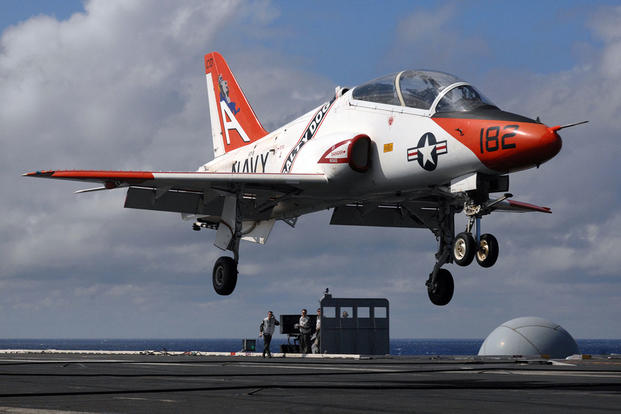The Navy's number two officer has ordered that all recent hypoxia-like episodes -- both for the T-45 Goshawk trainer and the F/A-18 Hornet -- be placed under comprehensive review in hopes of coming up with a plan to fix the problems quickly.
In an April 21 memo obtained by Military.com, Vice Chief of Naval Operations Adm. Bill Moran directs Adm. Scott Swift, the commander of all naval forces in the Pacific, to lead the review, probing the "facts, circumstances and processes" surrounding recent cockpit episodes, including how Navy officials have addressed each incident.
"The seriousness in which the Secretary of the Navy and the Chief of Naval Operations view these incidents is reflected in the seniority of those leading the review," Moran wrote in the memo. "[Swift] and his team have full authority to draw on previous work and subject matter experts from across the naval aviation and Navy medicine enterprise to assist in their task."
At the end of this 30-day review, Moran added, the review team will be able to validate current actions being taken and recommend additional tasks, if needed, to solve the problem.
A persistent trend of pilots suffering tingling and numbness in their extremities, shortness of breath, and other hypoxia-like symptoms during T-45 and Hornet flights came to a head earlier this month when Fox News reported that some 100 T-45 instructor pilots had refused to fly, citing safety concerns with the aircraft. Days later, the Navy announced the start of what would be a 12-day temporary grounding of the entire fleet of 197 T-45 trainers to review the concerns and come up with a plan to move forward.
On April 18, senior instructor pilots were allowed to resume flights with a 10,000-foot altitude limit and modifications to the mask apparatus that bypassed the onboard oxygen generation system. In the meantime, Naval Air Forces widened the team working on the cockpit problem, bringing in aeromedical experts, industry professionals, and NASA engineers, among others to consult.
But as Military.com first reported, there was a new cockpit episode the same day the senior instructors got back in the cockpit. A pair of pilots out of Kingsville, Texas, got headaches and felt other oxygen deprivation symptoms after conducting aerial maneuvers at the top of the altitude limit. In response, the Navy imposed new restrictions, limiting pilots to 5,000 feet in altitude and two Gs.
In his memo, Moran said Swift could decide the makeup of his review team, but requested it include representation from the engineering, aeromedical, fleet aviation, legal and public affairs communities.
In a release, Navy officials added that the service is taking an "unconstrained resource" approach to fixing the cockpit oxygen problems, and that the issue continues to be the number one safety priority for naval aviation.
-- Hope Hodge Seck can be reached at hope.seck@military.com. Follow her on Twitter at@HopeSeck.





























